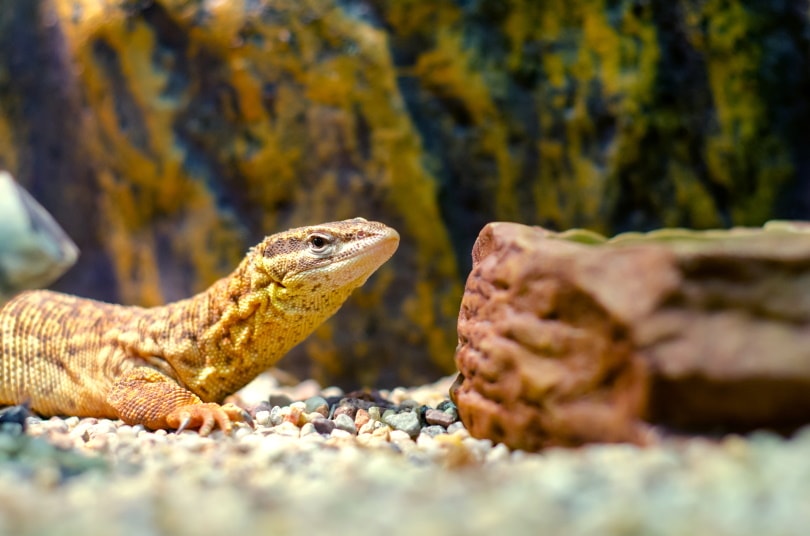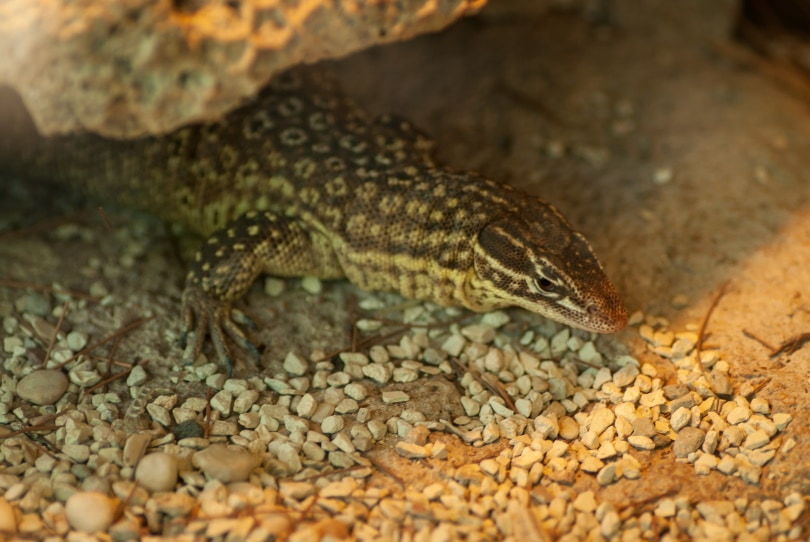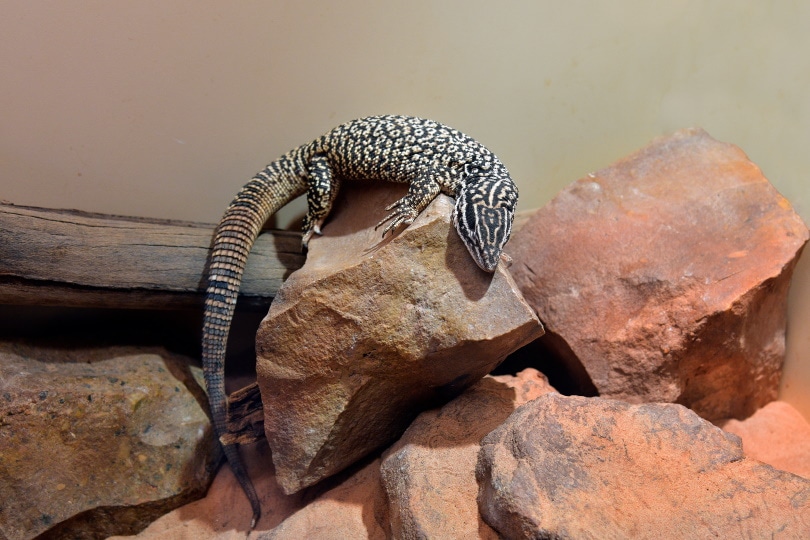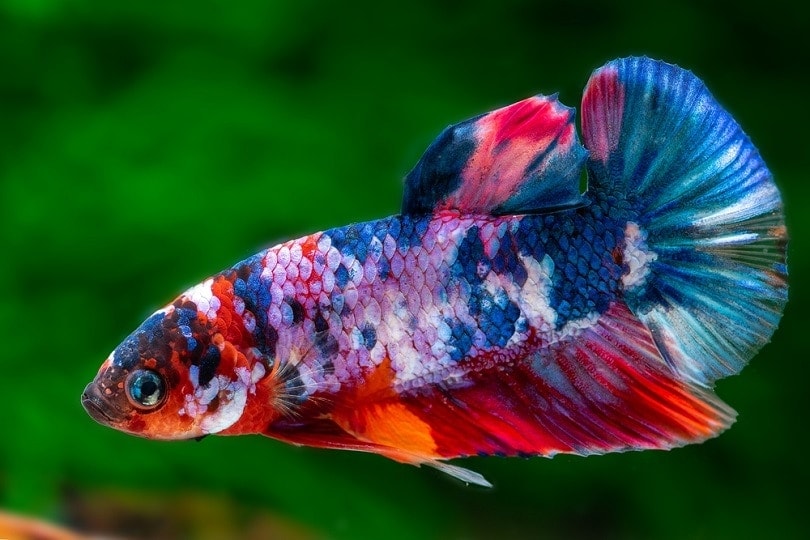
Reptile pets are getting more popular every year, and they make a great first pet for a child. The Ackie monitor resembles a Komodo dragon and has a calm and mellow temperament. It can get quite large, often reaching more than 24 inches, so it’s fun to watch them grow. Keep reading while we take a closer look at these delightful pets to learn some new facts and see if they are right for your home.
 Quick Facts About the Ackie Monitor
Quick Facts About the Ackie Monitor
| Species Name | V. acanthurus |
| Family | Varanidae |
| Care Level | Moderate |
| Temperature | 80–120 degrees Fahrenheit |
| Temperament | Calm, gentile |
| Color Form | Brown |
| Lifespan | 15 – 20 years |
| Size | 24 – 28 inches |
| Diet | Invertebrate, insects |
| Minimum Tank Size | 120-gallon tank |
| Tank Set-Up | Rocks, branches, plants |
Ackie Monitor Overview

The Ackie monitor has several other names, including the ridge-tailed monitor and Spiny-tailed monitor. It’s a medium-sized lizard that often grows to about 2 feet long, but some can grow to almost 3 feet. The tail makes up a large part of the lizard’s total size, and it has bright yellow spots and a brown body. You can find the Ackie monitor in its natural habitat if you travel to northeastern Australia.
How Much Do Ackie Monitors Cost?
You should set aside $500-$1,000 for your Ackie monitor, depending on its age and breeder. You are unlikely to find one in a pet store. You will need to do a bit of online research to find a good breeder. We recommend choosing one with lots of reviews, so you will know the breeder has been in business a while and is trustworthy.
You can also expect to pay close to $1,000 for a 120-gallon tank and other supplies to house your new pet, and you will also have ongoing expenses as you purchase substrate, food, and other items that your Ackie will need.
Typical Behavior & Temperament

Ackies do not seem to mind captivity and can live a long life as long as their tank is large enough. It’s very calm and rarely gets aggressive unless it is frightened. When it’s scared, it can whip its tail and snap at you, so we don’t recommend handling it when it’s upset. It’s quite curious and will usually keep watch over the room from inside its habitat.
Appearance & Varieties
There are three varieties of the Ackie monitor lizard, the Red Ackie, Yellow Ackie, and the Island Ackie. The Island Ackie is not a pet, and the other two get their names from the colored spots on their backs. The Red Ackie is the largest of the group but is much less common. Most pets are Yellow Ackies, and they have spots that can range from tan to bright yellow. Their tails are longer than their head and body, and there are spines toward the tip, giving it a prehistoric appearance. They have a pointed head, with large eyes and ear openings.
How to Take Care of an Ackie Monitor
Habitat, Tank Conditions & Setup

Before your Ackie is fully grown, you can keep them in a 40-gallon tank to help them feel more secure, but once they become an adult, it will need a tank no smaller than 120 gallons. You will also need to keep the cage incredibly hot to provide the Ackie with an environment they enjoy. You will need to keep the basking area of the habitat at 120–150 degrees F, and you will need to keep the other end of the tank closer to 80 degrees F.
An Ackie doesn’t like to climb but does enjoy burrowing in the sand, so you will need to provide a thick substrate of 6–12 inches. Most owners use sand, coconut fiber, or cypress chips.
The tank should be solid glass, 48” W x 24” D x 24” H. The glass should be thick, and the top should have a screen to allow for adequate ventilation. Adding natural rocks can help recreate an Ackie’s environment, and your pet can use them to hide if it feels threatened. You can also create more hides out of slate, resin, and other materials to make it feel more comfortable. You will also need to keep the humidity between 65%–85% at all times.
Does an Ackie Monitor Get Along with Other Pets?
Ackie monitors don’t mind living together, but the males can sometimes get into territorial disputes, so it’s better to keep females or one male with one or more females. Because of their unique habitat, most owners don’t recommend keeping other animals in the same tank.
What to Feed Your Ackie Monitor
Your Ackie monitor will eat a wide range of invertebrates and insects, including grasshoppers, beetles, cockroaches, snails, caterpillars, and more. At home, you will likely feed them crickets, mealworms, and waxworms. It will also need a constant source of fresh, clean water without any chlorine or other chemicals.
Keeping Your Ackie Monitor Healthy
The Ackie monitor is hardy and typically lives 15–20 years if kept in a stable, safe environment. The biggest problem it faces is metabolic bone disease (MBD), which is a serious condition that results from insufficient calcium in the diet. The lack of calcium causes the bone to become soft and brittle, resulting in immobilization and death. Dusting the insects with a calcium powder supplement can prevent MBD.
Another health issue that your Ackie monitor might face is obesity. Feeding your pet a diet high in waxworms or other fatty insects can cause them to gain weight. Keeping waxworms as a treat and feeding plenty of crickets will cause your reptile to be more active and can help it maintain an ideal weight.
Breeding

Breeding is possible if you have a male and a female, but the process of giving birth is very hard on the female, so you’ll need to make sure she is in good health before you get started. Wild Ackies mate from December to March, but it can occur at any time in captivity. The male will initiate, and mating can occur intermittently for up to 5 days. The gravid female will require plenty of food, and she should begin looking for an area in the tank that is about 86 degrees F to lay her eggs. She will lay eggs about 20 days later and will require plenty of water and food to get back to good health when she finishes.
The Ackie monitor can lay multiple clutches of eggs as long as there is adequate food and the temperature is correct.
 Are Ackie Monitors Suitable for You?
Are Ackie Monitors Suitable for You?
The Ackie monitor can be a great pet for the right people. The large, high temperature and humidity habitat can be a lot of work for a child or someone without experience. Children also like to pick up and pet their animals, and it could take some time for your new Ackie monitor to get used to its new home. If you need something more suitable for children, there are several great choices, including the bearded dragon. However, if you have the time and budget to maintain the large habitat, the Ackie monitor makes a fantastic pet that is lively and fun to watch chase crickets. It has very few health problems, can live 15–20 years, and grows more than 2 feet long.
We hope you have enjoyed reading over this review and have learned something new. If we have convinced you to get one of these amazing animals for your home, please share this guide to the Ackie monitor on Facebook and Twitter.
Featured Image Credit: reptiles4all, Shuterstock

 Quick Facts About the Ackie Monitor
Quick Facts About the Ackie Monitor





